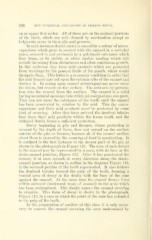Page 250 - My FlipBook
P. 250
106 THE TECHNICAX, PROCEDUEES IN FILLING TEETH.
on an upper first molar. All of these are on the occlusal portions
of the teeth, which are well cleaned by mastication except as
lodgments occur in these pits and grooves.
In each instance dental caries is caused by a colony of micro-
organisms which grow in contact with the enamel in a secluded
place, covered in and protected by a gelatinoid substance which
they form, or by debris, or other similar coating which will
seclude the colony from disturbance and allow continuous growth.
In this seclusion they form acid products which are protected
from washings by the general fluids of the mouth, which would
dissipate them. This latter is a necessary condition in order that
the acid formed may act upon the calcium salts of the enamel and
destroy it. In acting upon enamel microorganisms never enter
the tissue, but remain on the surface. The acid acts by percola-
tion into the enamel from the surface. The enamel is a solid
having no natural openings into which microorganisms can grow.
They can not enter the substance of the tooth until the enamel
has been jDenetrated by solution by the acid. This far micro-
organisms and their acid products must be protected by some
kind of covering. After they have entered the dentinal tubules
they form their acid products within the tissue itself, and the
softened dentin forms a sufficient protection.
Decay beginning in pits and fissures, where protection is
secured by the depth of these, does not spread on the surface
outside of the pits or fissures, because all of the enamel surface
about them is cleaned by the scouring of food in mastication. It
is confined in the first instance to the deeper part of the pit, as
shown by the photograph in Figure 111. The area of such decays
in the enamel may be represented by a cone, with its base at the
dento-enamel junction. Figure 112. After it has penetrated the
enamel, it at once spreads in every direction along the dento-
enamel junction, as shown in outline in the diagram Figure 112,
in the occlusal portion of the tooth represented. It also follows
the dentinal tubules toward the pulp of the tooth, forming a
conical area of decay in the dentin with the base of the cone
against the enamel. At the same time the enamel decays from
within outward (backward decay of enamel) in the area which
has been undermined. This finally causes the enamel covering
to crumble. This form of decay is shown in the photograph.
Figure 113, in a case in which the point of the cone has extended
to the pulp of the tooth.
In the preparation of cavities of this class it is only neces-
sary to remove the enamel covering the area undermined by


